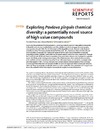Please use this identifier to cite or link to this item:
https://accedacris.ulpgc.es/handle/10553/69387
| DC Field | Value | Language |
|---|---|---|
| dc.contributor.author | Fernandes, Tomásia | en_US |
| dc.contributor.author | Martel, Antera | en_US |
| dc.contributor.author | Cordeiro, Nereida | en_US |
| dc.date.accessioned | 2020-01-25T06:08:22Z | - |
| dc.date.available | 2020-01-25T06:08:22Z | - |
| dc.date.issued | 2020 | en_US |
| dc.identifier.issn | 2045-2322 | en_US |
| dc.identifier.other | Scopus | - |
| dc.identifier.uri | https://accedacris.ulpgc.es/handle/10553/69387 | - |
| dc.description.abstract | To uncover the potential of Pavlova pinguis J.C. Green as a natural source of value added compounds, its lipophilic extracts were studied before and after alkaline hydrolysis using gas chromatography-mass spectrometry (GC-MS). The GC-MS analysis of the lipophilic extracts showed a wide chemical diversity including 72 compounds distributed by fatty acids (29), sterols (14), fatty alcohols (13) and other lipophilic compounds (16). Fatty acids represented the main class of identified compounds presenting myristic, palmitic, palmitoleic and eicosapentaenoic acids as its main components. Through the ∑ω6/∑ω3 ratio (0.25) and sterol composition it was possible to observe that P. pinguis is a valuable source of ω3 fatty acids and stigmasterol (up to 43% of total sterols). After alkaline hydrolysis, fatty acids and fatty alcohols content increased by 32 and 14% respectively, in contrast to, monoglycerides which decreased by 84%. The long chain alcohols content enables the exploitation of this microalga as a source of these bioactive compounds. Smaller amounts of sugars and other compounds were also detected. The present study is a valuable reference to the metabolite characterization of P. pinguis and shows the potential of this microalga for nutraceutical and pharmaceutical industries. | en_US |
| dc.language | eng | en_US |
| dc.relation.ispartof | Scientific Reports | en_US |
| dc.source | Scientific reports [ISSN 2045-2322], v. 10 (1), p. 339 | en_US |
| dc.subject | 241705 Biología marina | en_US |
| dc.subject | 241707 Algología (ficología) | en_US |
| dc.subject.other | Pavlova pinguis | en_US |
| dc.title | Exploring Pavlova pinguis chemical diversity: a potentially novel source of high value compounds | en_US |
| dc.type | info:eu-repo/semantics/article | en_US |
| dc.type | Article | en_US |
| dc.identifier.doi | 10.1038/s41598-019-57188-y | en_US |
| dc.identifier.scopus | 85077941014 | - |
| dc.contributor.authorscopusid | 57202652497 | - |
| dc.contributor.authorscopusid | 57213671622 | - |
| dc.contributor.authorscopusid | 7004319456 | - |
| dc.description.lastpage | 339 | - |
| dc.identifier.issue | 1 | - |
| dc.description.firstpage | 339 | - |
| dc.relation.volume | 10 | - |
| dc.investigacion | Ciencias | en_US |
| dc.type2 | Artículo | en_US |
| dc.utils.revision | Sí | en_US |
| dc.identifier.ulpgc | Sí | es |
| dc.description.sjr | 1,24 | |
| dc.description.jcr | 4,379 | |
| dc.description.sjrq | Q1 | |
| dc.description.jcrq | Q1 | |
| dc.description.scie | SCIE | |
| item.fulltext | Con texto completo | - |
| item.grantfulltext | open | - |
| crisitem.author.dept | GIR IOCAG: Oceanografía Biológica y Algología Aplicada | - |
| crisitem.author.dept | IU de Oceanografía y Cambio Global | - |
| crisitem.author.orcid | 0000-0002-7450-0505 | - |
| crisitem.author.parentorg | IU de Oceanografía y Cambio Global | - |
| crisitem.author.fullName | Martel Quintana, Antera De Jesús | - |
| Appears in Collections: | Artículos | |
SCOPUSTM
Citations
20
checked on Jun 8, 2025
WEB OF SCIENCETM
Citations
19
checked on Jun 8, 2025
Page view(s)
208
checked on May 31, 2025
Download(s)
193
checked on May 31, 2025
Google ScholarTM
Check
Altmetric
Share
Export metadata
Items in accedaCRIS are protected by copyright, with all rights reserved, unless otherwise indicated.
